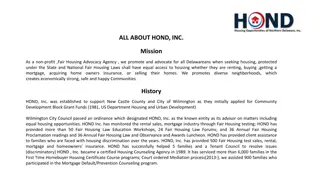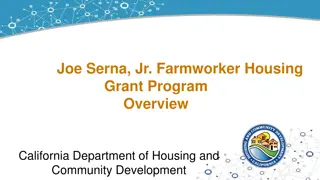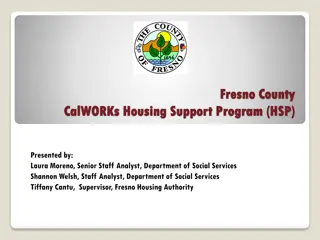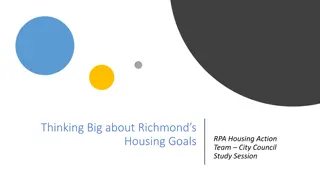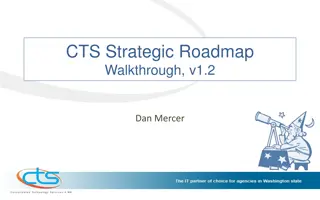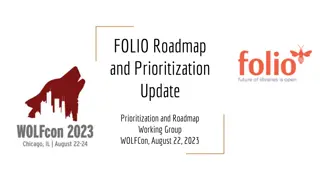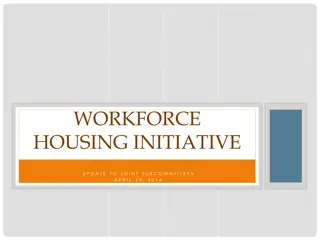Farmworker Housing Development Roadmap
This roadmap provides guidance for property owners and farm operators on the process of developing housing for farmworkers, highlighting common pitfalls and key steps like pre-application, planning, and permit approval. Learn about potential barriers such as water access, zoning approval, multi-departmental review, state oversight, and cost-saving construction options.
Download Presentation

Please find below an Image/Link to download the presentation.
The content on the website is provided AS IS for your information and personal use only. It may not be sold, licensed, or shared on other websites without obtaining consent from the author. Download presentation by click this link. If you encounter any issues during the download, it is possible that the publisher has removed the file from their server.
E N D
Presentation Transcript
Staff Introduction/Instructions to Roadmap Primer for how to use this resource Family-owned/operated farm applicants will likely not be development savvy. This roadmap can help applicants avoid repeated trips to the planning desk. Tailor the following template by identifying the materials, and state, local and regional approvals needed to get farmworker housing approved in your jurisdiction. This process map can serve as an informational tool to help your applicants make strategic decisions about timing of work and feasibility of their project before they invest. ***Anything in a yellow highlight is an area that we recommend customizing for your jurisdiction s rules and regulations***
Farmworker Housing Development Roadmap Introduction/Overview Are you a property owner/farm owner considering building housing for your workers?* What is farmworker housing? Farmworker housing is defined as housing units that are occupied by farmworkers and their immediate family members. This housing may or may not be occupationally restricted to farmworkers. Farmworkers are traditionally defined as people whose primary incomes are earned through permanent or seasonal agricultural labor. Farmworkers are generally considered to have special housing needs due to their limited income and the often unstable nature of their employment. Are you interested in building farmworker housing? You might be a: Farm Owner/Operator who wants to build housing for your employees Property Owner who has agriculturally-zoned land that you want to develop Affordable housing developer interested in exploring farmworker housing California Department of Housing and Community Development** Why is farmworker housing important? A safe and secure food supply requires a healthy, trained and stable workforce living in quality affordable housing. *Some definitions of farmworker include small-scale farm operators. **Agricultural Employee/Farmworker Definition: An agricultural employee, operator, or owner primarily engaged in an agricultural operation. This definition differs by jurisdiction, but usually includes ranching and dairy. Farmworker Housing Development Roadmap | 2
Farmworker Housing Development Roadmap Common Pitfalls This resource is designed to provide an overview of the development process for farmworker housing and to highlight areas for property owners to save time and money. STEP 1 Pre-Application Process STEP 2 Planning and Environmental Review STEP 3 Building Permit Application & Approval POTENTIAL BARRIERS POTENTIAL BARRIERS POTENTIAL BARRIERS Sewer/Water Access: Does your site have access to water and sewer? For most farmworker housing projects, an on-site water treatment system (OWTS) will be required. More information in next slides. Zoning Approval Process: Review your jurisdiction s zoning code and ask your Planning Department what the approval process for farmworker housing is. If your development requires a period of public comment, please anticipate additional time. Multi-departmental Review: In addition to the Planning and Environmental department, your project may be reviewed by additional departments. Anticipate an appropriate timeline. State Oversight: Building 5+ units may require an employee housing permit as well as approval to extend water/sewer services Save Money & Time on Construction: Consider exploring manufactured or pre-built homes early in the process. Farmworker Housing Development Roadmap | 3
Milestone Roadmap A standard farmworker housing project usually requires three steps of approval: STEP 1 Pre-Application Process STEP 2 Planning and Environmental Review STEP 3 Building Permit Application & Approval Share building permit application with other applicable agencies for their review Initial meeting with Planning department to review proposed development Submit application to Planning Department Review by applicable agencies Edits & Resubmission (if applicable) Initial conversations with Environmental Health department Additional Edits & Resubmission (if applicable) Note: This resource is designed to help people who are interested in farmworker housing understand major hurdles and barriers early in the development process. Public Hearing (if applicable) Building Permit Approval This roadmap also clarifies local and state considerations for farmworker housing. Planning Permit Approval Construction & Inspection Bolded steps have additional information on the following pages. Farmworker Housing Development Roadmap | 4
Detailed Roadmap STEP 1: Pre-Application Process Check your jurisdiction s requirements related to farmworker housing. Schedule a pre-approval meeting or consultation with your Planning Department and Environmental Health Department. [Insert links or update department names as needed] Consider the following as you prepare for your meeting: Planning Department Environmental Health Services Initial meeting with Planning department to review proposed development Initial conversations with Environmental Health department # of Units: How many units do you want to build? 1 unit 2-5 units 5+ units If you construct more than 5 units, note that you may encounter additional oversight hurdles at the state level as you seek water and sewer options in your application.** Consider building an Accessory Dwelling Unit (ADU) if you have a property that has an existing home. [Link to your jurisdiction s ADU policy/program] Additional considerations for early pre-application stages on next slide. Check if your local ordinance has a streamlined approval process for small- scale permanent agricultural employee housing (usually less than 5 units) (see Template Zoning Ordinance) **A water supply for any development consisting of five or more service connections is classified as a small state water system and water supply to a project serving 25 or more people per day, for at least 60 days per year, is classified as a public water system. Both water system classifications trigger oversight authority by your Regional Water Quality Control Board, which would require an attempt to obtain a connection from an urban service area prior to considering an application. For most farmworker housing projects, an on-site water treatment system (OWTS) will be required. Additionally, if housing 5+ farmworkers, you will need to obtain an Employee Housing Permit from California HCD. [Yellow highlighted areas are for recommended customization and edits to make this template specific to your jurisdiction.] Farmworker Housing Development Roadmap | 5
Detailed Roadmap STEP 1: Pre-Application Process Check your jurisdiction s requirements related to farmworker housing and revise the following. Schedule a pre-approval meeting or consultation with your Planning Department and Environmental Health Department. Consider the following as you prepare for your meeting: Planning Department Environmental Health Services Initial meeting with Planning department to review proposed development Initial conversations with Environmental Health department Zoning: What is permitted on your parcel? Water & Sewage What is your parcel zoned for? Based on your jurisdiction s zoning code and State law, projects that meet certain requirements may be expedited. [Revise and add zoning specifications] *** If your parcel is protected by any conservation easements or the Williamson Act? Inquire about any additional paperwork needed to build farmworker housing on your protected land.*^ Does your site have an on-site water treatment system (OWTS)? If not, how do you plan to address water and sewer needs? Connection to an urban service area Construct OWTS Additional Considerations Permanent or Temporary Development Maximum Development Size & Minimum Lot Size Design Requirements Floodplain: Use FEMA s flood maps to check if you are in a floodplain, which could make development difficult or impossible Access to publicly-maintained road ***California State Law: California Health and Safety Code Sections 17021.5 and 17021.6 adopted in 2013 require agricultural employee housing to be permitted by-right, without a conditional use permit (CUP), in single-family zones for six or fewer persons and in agricultural zones with no more than 12 units or 36 beds. Please check your local jurisdiction s planning code to see how they permit employee housing and if there are additional local zoning regulations that you need to consider. *^According to California State Assembly Bill 1505, farmworker housing is a compatible use on Williamson Act Land. NOTE: Check with your Environmental Health Department representative to understand water and sewage requirements for your project. Understanding your options for water and sewage and having a cost range in mind early on may save you time and money. Farmworker Housing Development Roadmap | 6
Detailed Roadmap STEP 2 : Planning and Environmental Review Check your jurisdiction s requirements related to farmworker housing and revise the following. Based on your initial consultation, prepare your application for the Planning Department. After you submit your application, your proposed project may undergo the following approval process: Planning Department Environmental Health Services Review by applicable agencies Edits & Resubmission (if applicable) Submit application to Planning Department Public Hearing (if applicable) Planning Permit Approval Sample Planning Permit Application Materials [Please customize this checklist to your jurisdiction. The below checklist is based off the San Mateo County Farm Labor Housing Guidebook.] Planning Permit Application Form & Checklist Farmworker Housing-Specific Application Coastal Development Permit Application, if applicable Agricultural District/Conservation District Permit Application, if applicable Use Permit, if required Grading Permit Application, if required Environmental Information Disclosure Form Proof of Ownership (copy of deed/tax bill) Well pump test and water quality results, if applicable Drawings, including : Scaled site plan depicting parcel boundaries, easements, existing and proposed structures, access, driveways, water lines, storage tanks, septic tanks and leach fields, location and type of existing agriculture Floor plans Utility Plan, including conceptual on-site wastewater treatment system design, if applicable) Grading and Drainage Plan Erosion Control Plan Driveway/Access Plan Farmworker Housing Development Roadmap | 7
Detailed Roadmap STEP 2 : Planning and Environmental Review Check your jurisdiction s requirements related to farmworker housing and revise the following. Based on your initial consultation, prepare your application for the Planning Department. After you submit your application, your proposed project may undergo the following approval process: Planning Department Environmental Health Services Review by applicable agencies Edits & Resubmission (if applicable) Submit application to Planning Department Public Hearing (if applicable) Planning Permit Approval If the site is not already connected to water and sewer service, many farmworker housing projects will require an Onsite Wastewater Treatment System (OWTS). During the planning permit review process, the Environmental Health Department will look for a sufficient water and sewage system. [Insert additional requirements] Based on your Planning Department s zoning requirements for farmworker housing, your project may be approved through a planning clearance or special permit, which would eliminate the need for a public hearing.* NOTE: [Insert any deed restriction or affidavit restrictions stating that this housing will only be used for farmworkers] [Insert jurisdiction information on specifics (i.e. unit size) that might lead to a public hearing and how long that would take] *A planning clearance is usually an administrative approval from the Planning Department. A special permit is subject to the specific provisions of your jurisdiction s planning process. Both a planning clearance and special permit do not require a public hearing. See Template Zoning Ordinance for more information. [Yellow highlighted areas are for recommended customization and edits to make this template specific to your jurisdiction.] Farmworker Housing Development Roadmap | 8
Detailed Roadmap STEP 3: Building Permit Application & Approval After you obtain your planning permit, prepare your application for your building permit. Planning, Environmental Health, Buildings, Public Works, Fire Authority, [Add additional departments] Share building permit application with other applicable agencies for their review Buildings Buildings Additional Edits & Resubmission (if applicable) Building Permit Approval Construction & Inspection Your application may be reviewed by subject matter experts, including but not limited to, Planning, Environmental Health, Buildings, Public Works, the Fire Authority, and [Insert additional departments]. Your review may consist of zoning, building code, water supply/onsite wastewater treatment systems, seismic/soil stability, drainage and grading, fire safety/access, [Insert additional requirements]. NOTE: If housing 5+ farmworkers, you will need to obtain an Employee Housing Permit from California HCD. NOTE: Consider opportunities to use manufactured or pre-built homes to save time and cost on construction. [Yellow highlighted areas are for recommended customization and edits to make this template specific to your jurisdiction.] Farmworker Housing Development Roadmap | 9
Detailed Roadmap STEP 3: Building Permit Application & Approval After you obtain your planning permit, prepare your application for your building permit. Planning, Environmental Health, Buildings, Public Works, Fire Authority, [Add additional departments] Share building permit application with other applicable agencies for their review Buildings Buildings Additional Edits & Resubmission (if applicable) Building Permit Approval Construction & Inspection Sample Building Permit Application Materials [Please customize this checklist to your jurisdiction. The below checklist is based off the San Mateo County Farm Labor Housing Guidebook.] Building Permit Application Form Development Plans Complete on-site wastewater treatment system design, if applicable Stormwater Review Form [Yellow highlighted areas are for recommended customization and edits to make this template specific to your jurisdiction.] Farmworker Housing Development Roadmap | 10
Additional Resources Water & Sewage Guidance (before you start) Building in rural, unincorporated areas can be difficult and have unexpected costs because of water and sewage requirements. However, we hope that this does not discourage you from pursuing this project. [Insert your jurisdiction s specific programs and guidance related to OWTS Are you looking for additional funding for your project? Check if your jurisdiction has any specific funds available for farmworker housing projects California HCD Joe Serna Jr. Farmworker Housing Grant Program USDA Section 514 and 516 Loan and Grant Program [Insert potential funding sources specific to your jurisdiction for farmworker housing] [Yellow highlighted areas are for recommended customization and edits to make this template specific to your jurisdiction.] Farmworker Housing Development Roadmap | 11
Additional Resources FAQs Q: Do I have to be a farm operator to build farmworker housing? A: No, anyone can build farmworker housing and most jurisdictions do not require farmworker housing to be on the same site as the agricultural operation. Q: Can my property be occupied by tenants who are not farmworkers? A: There are examples of larger-scale housing developments that have a set-aside for farmworker units. For smaller-scale developments, [Please double check with your Planning Department and any external funding sources you may have received to understand any tenant requirements and related tenant employment verification processes]. Q: Who I contact with follow-up questions? A: [Insert jurisdiction point of contact] Q: [Space to insert jurisdiction-specific FAQ] A: Q: [Space to insert jurisdiction-specific FAQ] A: [Yellow highlighted areas are for recommended customization and edits to make this template specific to your jurisdiction.] Farmworker Housing Development Roadmap | 12








